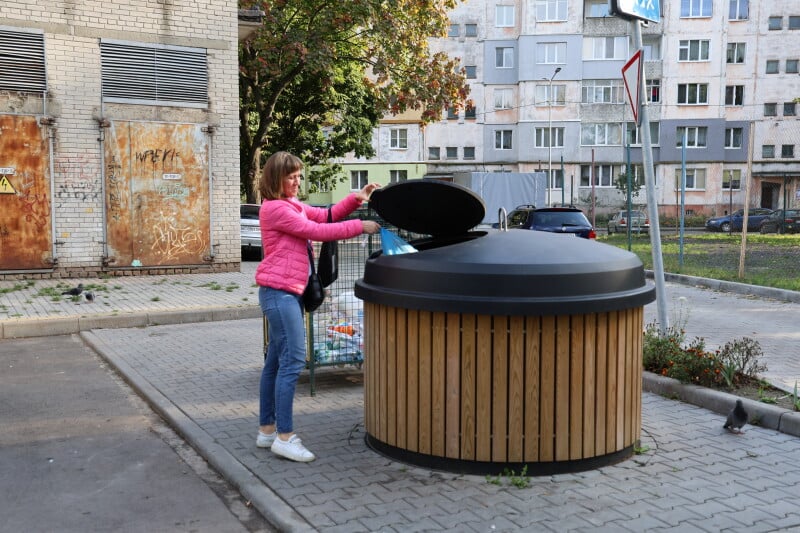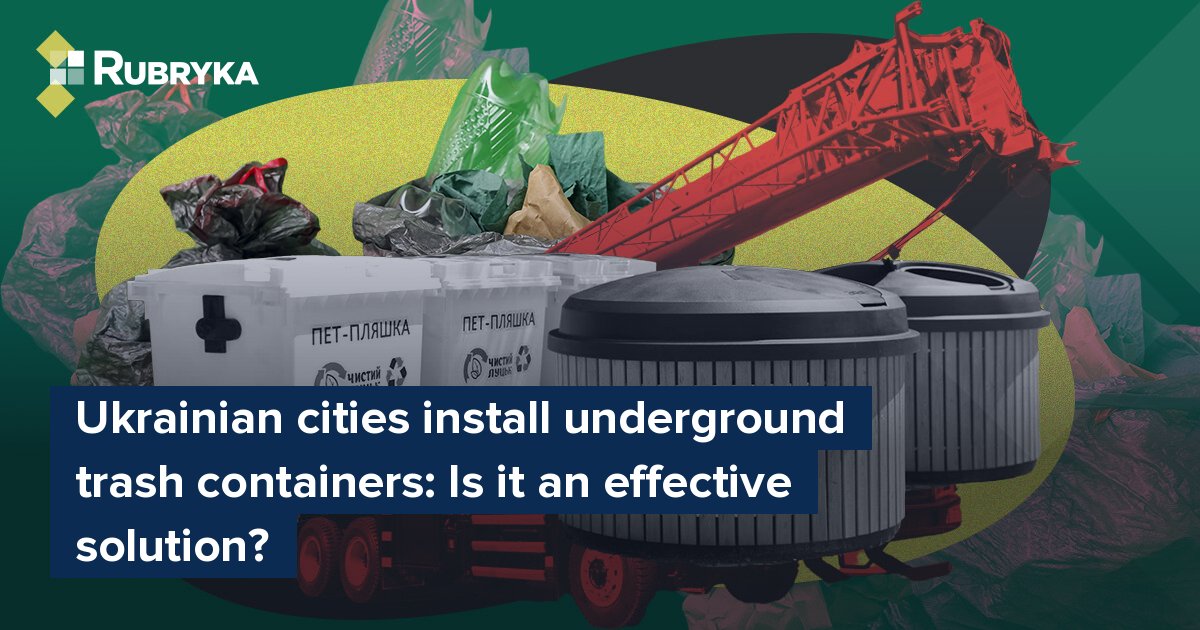
What's the problem?
According to environmental experts, each person in Ukraine produces around 300 kg of household waste annually. In large cities, most of this waste ends up in regular trash containers, often placed right next to residential buildings. The problem with these open containers is that trash can be blown away by the wind or scattered by animals. They also tend to leak, causing foul odors and attracting pests.
What's the solution?
To address the problem, many cities in Ukraine, including Lutsk, chose to install containers underground. For the second year in a row, Lutsk has been replacing the traditional open trash containers with semi-underground ones — the upgrade is part of a city program to replace old containers for collecting solid household waste.
How does it work?

Semi-underground garbage containers in Lutsk. Photo: Lutsk City Council
Lutsk Mayor Ihor Polishchuk shared that since the start of the program in 2023, the city has installed 60 underground containers at 29 locations. According to the official, about 30 of them were added this year. The containers have performed very well so far, with their structure proving to be durable and reliable. He pointed to a container on Veteraniv Street, which has been in use for over a year:
"No breakdowns. The bag inside hasn't been deformed or torn. So, the design is holding up well and proving its reliability," the mayor said.
What is a semi-underground container?

A semi-underground garbage container in action. Photo: Lutsk City Council
A semi-underground container equipped with a special trash bag inside can hold up to five cubic meters (5,000 liters) of mixed solid household waste.
The city council calculated that the cost of one semi-underground container is comparable to the price of four to five regular containers, their covers, and a storage platform. From a financial perspective, semi-underground containers are a wise investment, aesthetically pleasing, and better for sanitation.
Other benefits include better waste management, maintaining hygiene, and ensuring environmental safety in the area. The city also has two special garbage trucks designed to service these containers.

Ihor Polishchuk inspects semi-underground garbage containers in Lutsk. Photo: Lutsk City Council
"It's definitely a modern, European approach. Many European cities use semi-underground containers," Polishchuk noted, adding that the program will continue.
"We've received many requests from residential buildings and housing cooperatives, and we'll do our best to keep installing them as long as resources allow," the mayor added.
Does it really work?
A different perspective


Unloading of a semi-underground container. Photo: Lutsk City Council
"These containers can hold more waste at once, which is a big advantage," says Kateryna Raban, head of the public organization Zero Waste Lutsk. "I think they're a great idea, especially if installed in the right spots — like the city center or areas where open containers tend to create 'garbage dumps.' This will help keep the city looking clean for tourists."
However, the organization also raised some concerns about the widespread installation of these containers across the entire city. Their concerns include:
- Sorting: According to Raban, Lutsk is signing a contract with international partners to reduce waste, including a waste sorting program. There are doubts whether semi-underground containers, where people throw in everything, will fit into this program. Raban also pointed out that these containers, where the contents aren't visible, could make proper sorting more difficult. "People often sort based on what they see. If they see plastic, they throw more plastic in. No matter how many signs you put up, sorting doesn't work perfectly if people can't see what's inside. We need to focus more on educating the public," she explained.
- Cost: These containers are much more expensive and require more resources for maintenance. "The bags inside need to be replaced every two years, which will also come out of the city budget. Is it really worth it, considering the first issue?" Raban added.
- Masking the problem: Sofiko Sheshaberidze, another member of Zero Waste Lutsk, feels that semi-underground containers aren't solving the problem but simply covering it up. "The system's flaws, including bad odors, still exist — they're just hidden from sight," she said.
- Poor planning: Sofia Tesliuk, also from Zero Waste Lutsk, mentioned cases of poor planning when placing these containers. "For example, on Hulaka-Artemovskoho Street, [the city] allocated space for these containers right under people's windows, even though there's plenty of room behind the building. The area was dug up, residents protested, the police arrived, and in the end, nothing got done. It was a waste of time, money, and resources because of poor planning," Tesliuk commented.
What do the city services say?

Volodymyr Martseniuk. Photo: Lutsk City Council
Five more locations are currently being prepared for semi-underground containers. Volodymyr Martseniuk, director of Lutsk Special Communal Transport Enterprise Lutskspetskomuntrans — a utility contractor in Lutsk handling waste management — commented to Rubryka that each container saves the company over UAH 100,000 (about $2,500)
"This is a significant saving. If we complete the program and replace all the containers, the city, and the company could save around UAH 35–37 million ($8.5–9 million – ed.) per year," Martseniuk noted. "It's cost-effective and efficient in terms of logistics and operations, reducing vehicle maintenance costs. Plus, we'll have better control with GPS monitoring."
Martseniuk also mentioned that these containers could be adapted for separate waste collection by changing the lid and adding three compartments. The base remains the same, meaning the same container could be used for both mixed and sorted waste.
"Most likely, we'll start trying this next year. For example, where there's a lot of plastic waste, we'll start using containers designed for that," he explained.
For now, the city has placed containers for plastic bottles next to the semi-underground ones, with plans to add glass recycling bins in the future.

Containers for PET bottles near the semi-underground garbage container. Photo: Lutsk City Council
How can residents request a container?
Currently, if a housing cooperative in Lutsk wants to install this system, they must hold a meeting with the residents. The city council will then respond based on the meeting's protocol. What does this mean?
First, residents need to send a request to the mayor. The mayor approves funding for the location.
"But there's a condition from our side — co-financing. The housing cooperative will need to cover the cost of preparing the project documentation, which is roughly UAH 15,000–20,000 ($360–480)," Martseniuk added.






